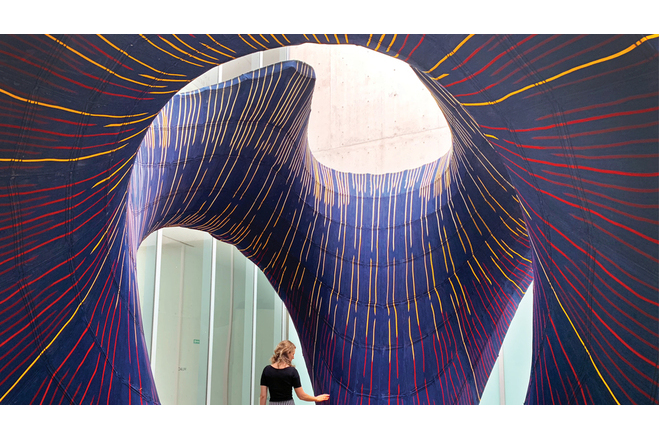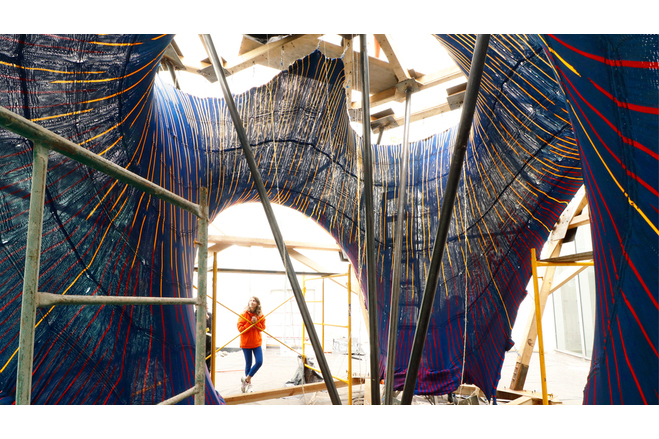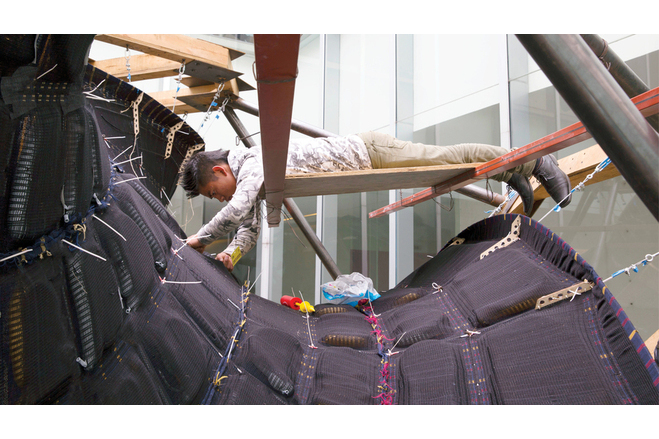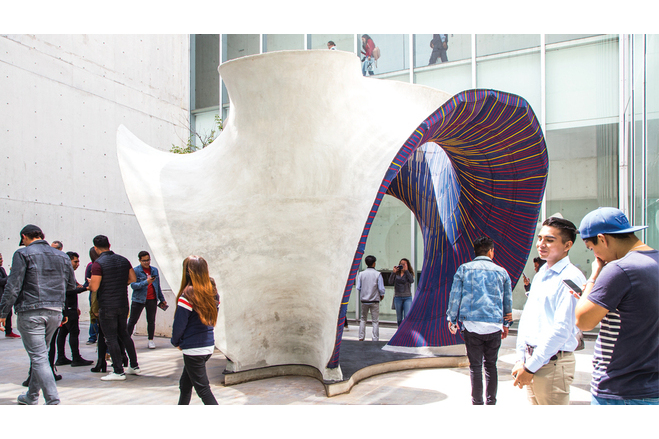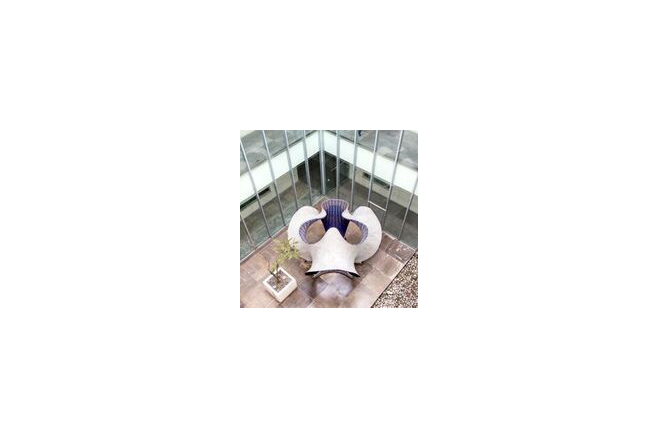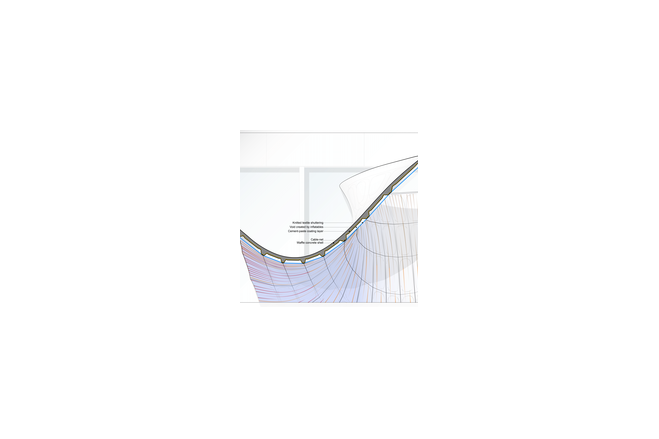KnitCandela at MUAC
General information
-
Home page
https://vimeo.com/297258002
-
Location address
Museo Universitario Arte Contemporáneo (MUAC), Mexico City
-
Location country
Mexico
-
Year of construction
2018
- Function of building
-
Climatic zone
Tropical - hot and wet all year
-
Primary function of the tensile structure
- Space defining elements
Description
Built at the Museo Universitario Arte Contemporáneo (MUAC) in Mexico City as part of the first exhibition of Zaha Hadid Architects in Latin America, KnitCandela is an homage to the famous Spanish-Mexican shell builder Félix Candela (1910 - 1997). It reimagines his spectacular concrete shells through the introduction of novel computational design methods and the KnitCrete formwork technology.
The shell’s dynamic geometry is inspired by the fluid forms of the traditional and colourful dress of Jalisco, Mexico. The builders’ nickname for the project was 'Sarape', which is a scarf or poncho with a stripe pattern. The shape also pays homage to Candela’s famous restaurant at Xochimilco, a trope he repeated in several subsequent projects.
While Candela relied on combining hyperbolic paraboloid surfaces (or “hypars”) to produce reusable formworks and thus reduce construction waste, KnitCrete allows for the realisation of a much wider range of anticlastic geometries. With this cable-net and fabric formwork system, expressive, freeform concrete surfaces can now be constructed efficiently, without the need for complex moulds.
KnitCandela’s thin, doubly-curved concrete shell with a surface area of almost 50m² and weighing more than 5tonnes, was applied on a KnitCrete formwork of only 55kg. The knitted fabric of the formwork system was brought to Mexico from Switzerland in a suitcase.
Collaboration
Designed and constructed by multiple teams in Europe and Mexico, the realisation of KnitCandela is the result of a collaborative effort that harnessed collective expertise in computational design, engineering and fabrication. The architectural design is the latest expression of the evolving search of the Computational Design Group of Zaha Hadid Architects (ZHCODE) for designs that utilise structural and constructional features to enhance the spatial experience of the user. For the realisation of this expression, the Block Research Group (BRG) of ETH Zurich introduced the KnitCrete formwork technology and developed the structural design and construction system. Architecture Extrapolated (R-Ex) managed the execution of the project on site in Mexico City as part of its continued engagement in the digitisation of building trades in Mexico.
KnitCrete
KnitCrete is a novel, material-saving, labour-reducing and cost-effective formwork system for the casting of doubly curved geometries in concrete. The KnitCrete technology is being developed at ETH Zurich by the Block Research Group in collaboration with the Chair for Physical Chemistry of Building Materials, as part of the Swiss National Centre of Competence in Research (NCCR) in Digital Fabrication.
KnitCrete formworks use a custom, 3D-knitted, technical textile as a lightweight, stay-in-place shuttering, coated with a special cement paste to create a rigid mould, and supported by additional falsework elements such as a tensioned cable-net or bending-active splines. Compared to conventional weaving, knitting minimises the need for cutting patterns to create spatial surfaces, allows for the directional variation of material properties, and simplifies the integration of channels and openings, for example, for the insertion of additional formwork elements, insulation, reinforcements, electrical components and technical systems for heating and cooling.
The hybrid and ultra-lightweight KnitCrete formworks are thus easily transportable, reduce the need for additional supporting structure and scaffolding, and simplify the logistics on the construction site.
The 50m² of textile shuttering of the formwork for KnitCandela is made up of four long strips ranging from 15m to 26m in length. Each of the four pieces is a seamless, double-layered textile produced in one go. The two layers of the textile fulfil different tasks. The visible inside is an aesthetic surface that displays a colourful pattern and reveals traces of the supporting cable-net falsework system. The backside fulfils technical needs by including features for inserting, guiding and controlling the position of additional formwork elements.
The pockets created between the two layers as part of the spatial knitting process are inflated using standard modelling balloons. These inflated pockets become cavities in the cast concrete, forming a structurally efficient waffle shell without the need for a complex, wasteful formwork. On the technical side of the textile, the pockets have different knit densities to control the inflated shape and openings for the insertion of the balloons, such that differently sized cavities can be created with one standard balloon size.
The interplay between the soft, warm, colourful fabric on the inside of the shell and its hard, cold concrete exterior is visible from all viewing angles. The stripe pattern visualises the short rows typical of the knitting fabrication process and expresses the radial symmetry of the shape. The pattern along with the simultaneous visibility of the soft inside and the hard outside of the shell, enhances the spatial experience of the curvatures of the shape and the space it defines.
Description of the environmental conditions
Material of the cover
Main dimensions and form
Duration of use
-
Temporary or permanent structure
Temporary
Involved companies
-
Engineers
Block Research Group
Editor
-
Editor
Evi Corne



